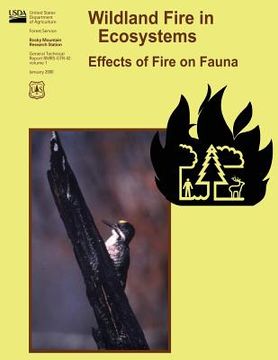Synopsis "Wildland Fire in Ecosystems: Effects of Fire on Fauna (in English)"
Fire regimes-that is, patterns of fire occurrence, size, uniformity, and severity-have been a major force shaping landscape patterns and influencing productivity throughout North America for thousands of years. Faunal communities have evolved in the context of particular fire regimes and show patterns of response to fire itself and to the changes in vegetation composition and structure that follow fire. Animals' immediate responses to fire are influenced by fire season, intensity, severity, rate of spread, uniformity, and size. Responses may include injury, mortality, immigration, or emigration. Animals with limited mobility, such as young, are more vulnerable to injury and mortality than mature animals. The habitat changes caused by fire influence faunal populations and communities much more profoundly than fire itself. Fires often cause a short-term increase in productivity, availability, or nutrient content of forage and browse. Fires generally favor raptors by reducing hiding cover and exposing prey. Small carnivores respond to fire effects on small mammal populations (either positive or negative). Large carnivores and omnivores are opportunistic species with large home ranges. Their populations change little in response to fire, but they tend to thrive in areas where their preferred prey is most plentiful-often in recent burns. In forests and woodlands, understory fires generally alter habitat structure less than mixed severity and stand-replacement fires, and their effects on animal populations are correspondingly less dramatic. Stand-replacing fires reduce habitat quality for species that require dense cover and improve it for species that prefer open sites. Population explosions of wood-boring insects, an important food source for insect predators and insect-eating birds, can be associated with fire-killed trees. Woodpecker populations generally increase after mixed-severity and stand-replacement fire if snags are available for nesting. Secondary cavity nesters, both birds and mammals, take advantage of the nest sites prepared by primary excavators. Many animal-fire studies depict a reorganization of animal communities in response to fire, with increases in some species accompanied by decreases in others. Like fire effects on populations, fire effects on communities are related to the amount of structural change in vegetation. Bird abundance and diversity are likely to be greatest early in succession. When shrub or tree canopy closure occurs, species that prefer open sites and habitat edges decline and species that prefer mature structures increase. Major changes to fire regimes alter landscape patterns, processes, and functional linkages. These changes can affect animal habitat and often produce major changes in the composition of faunal communities. In many Western ecosystems, landscape changes due to fire exclusion have changed fuel quantities and arrangement, increasing the likelihood of large or severe fires, or both. Where fire exclusion has changed species composition and fuel arrays over large areas, subsequent fires without prior fuel modification are unlikely to restore presettlement vegetation and habitat. In many desert and semi desert habitats where fire historically burned infrequently because of sparse fuels, invasion of weedy species has changed the vegetation so that burns occur much more frequently. Many animals in these ecosystems are poorly adapted to avoid fire or use resources in postfire communities. Collaboration among managers, researchers, and the public is needed to address tradeoffs in fire management, and fire management must be better integrated with overall land management objectives to address the potential interactions of fire with other disturbances such as grazing, flood, wind throw, and insect and fungus infestations.

